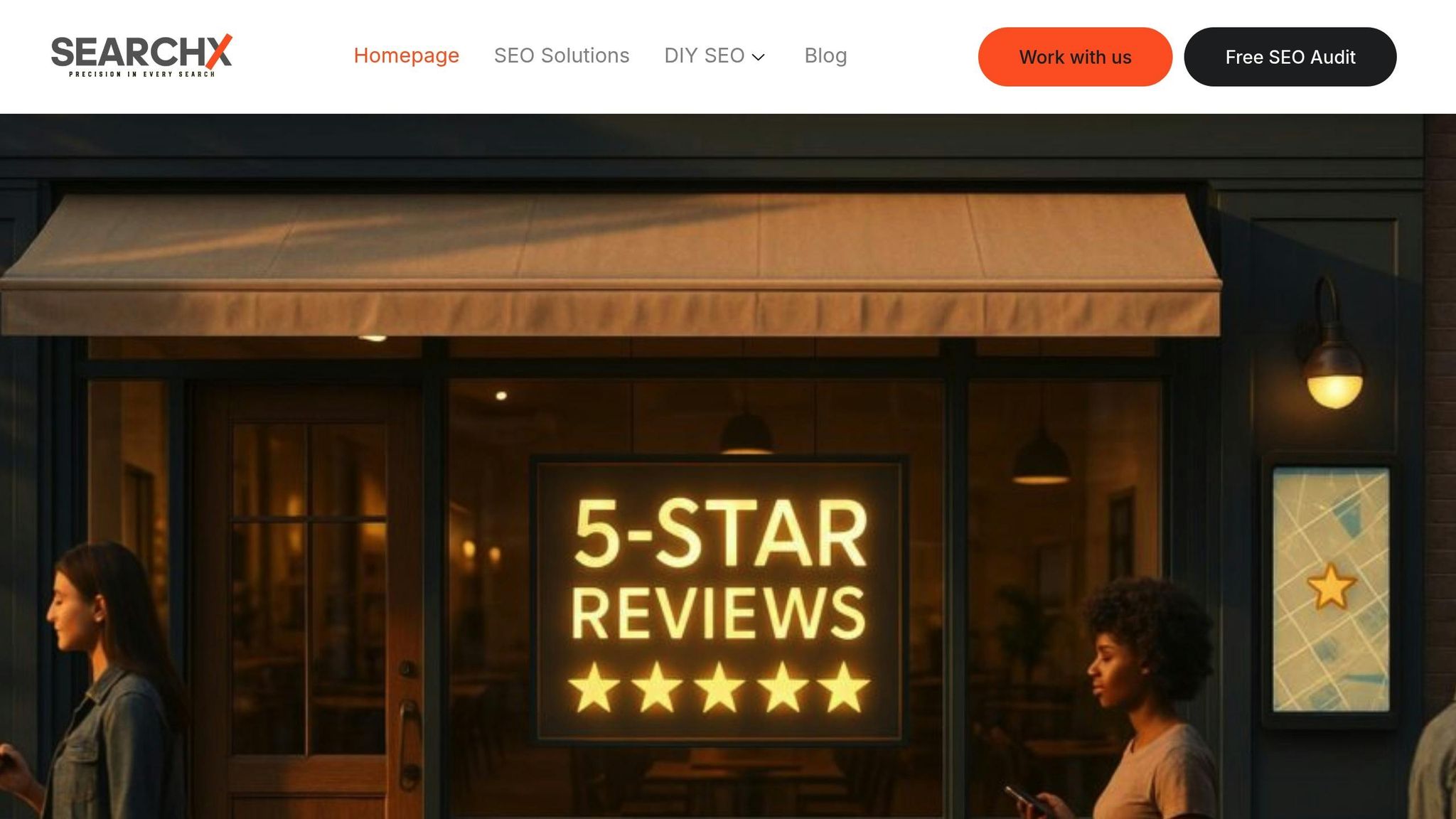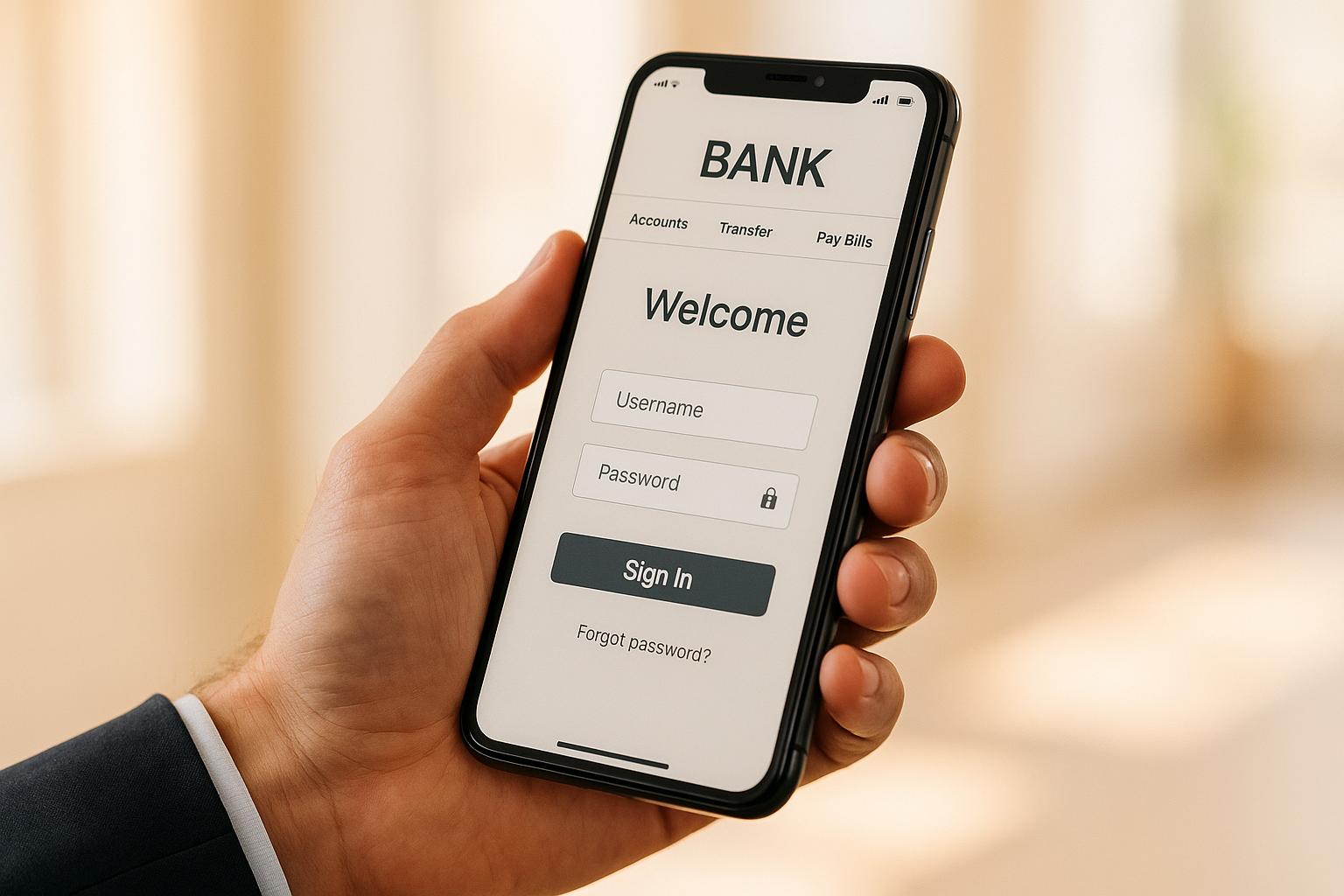Mobile content is now critical for banks to rank well in search results and meet customer expectations. Here’s why:
- Mobile-first indexing: Google prioritizes mobile-optimized content for rankings since 2021.
- User behavior: Mobile users want quick answers, local info (e.g., "ATM near me"), and easy navigation.
- SEO essentials: Fast-loading pages, concise content, and trust signals (like security badges) are key.
- Voice search growth: Banks must optimize for queries like "mortgage rates near me."
- E-E-A-T standards: Google values expertise, authority, and trust in financial content.
To stay competitive, banks must focus on mobile design, clear content, and strong security while adapting to voice search and AI-driven tools.
Core Elements of Mobile-Friendly Banking Content
Creating effective mobile banking content isn’t just about shrinking desktop pages to fit smaller screens. It requires a thoughtful approach that prioritizes user experience and search engine performance. To achieve this, banks should focus on three key areas: responsive design, clear and actionable content, and building trust using Google’s E-E-A-T framework.
Responsive Design and Mobile User Experience
Responsive design ensures your banking website works seamlessly across all screen sizes. Since Google factors mobile page experience into its rankings, a poorly optimized mobile site can hurt your visibility in search results.
Start with mobile-first design principles. Navigation menus and interactive elements should be touch-friendly, enabling users to tap with ease. Core banking features – like account login, balance checks, and branch locators – should be instantly accessible. Using ample white space not only improves readability but also helps reduce bounce rates.
Spacing between touch targets is another critical detail. It prevents accidental taps, which can frustrate users and give a negative impression of your site. Additionally, with mobile users often relying on varied cellular networks, consistent load speeds are non-negotiable.
Once your design is optimized, the next step is creating content that’s both clear and actionable.
Writing Clear and Actionable Mobile Banking Content
Mobile users skim content quickly, so your message needs to be scannable, concise, and action-driven. Every word counts when attention spans are short.
Craft short, straightforward headlines – they enhance both readability and SEO. Break up text into smaller paragraphs and use plenty of white space to make it easier to read on small screens. When it comes to call-to-action buttons, specificity is key. Instead of vague phrases like "Learn More", use direct prompts such as "Check Rates", "Apply Now," or "Find ATM" to guide users clearly.
Readable text matters too. Choose a large enough font size and ensure strong contrast between text and background. Simplify financial jargon whenever possible. For example, spell out "annual percentage yield (APY)" the first time you mention it. This makes your content more accessible and engaging for a broader audience.
By keeping your content clear and concise, you not only connect better with mobile users but also boost your site’s SEO performance.
Building Trust Through E-E-A-T in Banking Content
Beyond design and content, trust is the cornerstone of effective banking websites. Google’s E-E-A-T framework – Experience, Expertise, Authoritativeness, and Trustworthiness – is especially important for financial topics that fall under the "Your Money or Your Life" (YMYL) category. These topics directly impact people’s financial well-being, so Google holds them to higher standards for quality and credibility.
Experience highlights first-hand knowledge of banking services. Content written by real industry professionals carries more weight. Including author names, photos, and bios that showcase their roles within the bank can significantly enhance credibility.
Expertise means demonstrating deep knowledge of financial topics. Content should be written or reviewed by certified financial advisors or seasoned professionals. Highlighting credentials and certifications builds authority. Using schema markup to emphasize these qualifications can also help search engines better understand your content.
Authoritativeness is about external recognition. Banks can establish authority by earning backlinks from reputable financial websites, publishing original research, and offering practical tools like mortgage calculators or detailed how-to guides. Engaging with industry leaders on social media and participating in financial discussions can further reinforce your standing.
Trustworthiness is non-negotiable, especially for mobile users who often make quick decisions. Strengthen trust by maintaining secure site protocols, providing clear contact details, and being transparent about policies, risks, and fees.
The addition of "Experience" to E-E-A-T in December 2022 underscores the importance of authentic, first-hand knowledge over AI-generated content. For banks, this means showcasing employee expertise and sharing customer success stories. Highlighting genuine experiences not only builds credibility but also enhances both user satisfaction and mobile SEO performance – critical for staying competitive in the digital banking space.
Technical Requirements for Mobile Banking SEO
When it comes to mobile banking, technical performance is the backbone of both user engagement and SEO success. A seamless experience can keep users coming back, while also boosting search rankings. To stay ahead in this competitive space, banks need to excel in three key areas: Core Web Vitals, mobile security protocols, and simple navigation systems. These factors directly influence how well a site performs for users and search engines alike. Let’s break down the essential metrics and standards that ensure mobile banking sites deliver top-notch performance.
Core Web Vitals and Mobile Site Speed
Google’s Core Web Vitals focus on three critical aspects of user experience: loading speed (Largest Contentful Paint, or LCP), interactivity (First Input Delay, or FID), and visual stability (Cumulative Layout Shift, or CLS). For banking websites, acing these metrics isn’t just a nice-to-have – it’s a must. Financial transactions demand reliability and lightning-fast responsiveness.
- Loading Speed: Customers expect to access account details or complete transactions quickly. Pages should load within 2.5 seconds to meet Google’s LCP benchmark. Common culprits for slow loading include heavy images, excessive JavaScript, and third-party scripts. To speed things up, compress images and use lazy loading for non-critical elements.
- Interactivity: When users tap buttons for transfers, payments, or logins, they expect immediate feedback. Keeping the First Input Delay under 100 milliseconds ensures smooth interactions. To achieve this, banks should reduce JavaScript execution times and prioritize key elements like login forms and navigation menus.
- Visual Stability: Unexpected layout shifts can frustrate users – especially during financial transactions. Imagine tapping the wrong button because a page element moved at the last second. To avoid this, reserve space for images, ads, and dynamic content, and aim for a CLS score below 0.1.
For an added boost, optimize for variable cellular networks by keeping page weight under 1.6MB and reducing server response times.
Mobile Security and HTTPS Requirements
Speed and responsiveness are crucial, but security is non-negotiable in mobile banking. Without robust security measures, trust erodes – and so do search rankings. Google has made HTTPS a ranking factor, and mobile users are particularly sensitive to security cues.
- HTTPS Encryption: Financial data must be protected during transmission. Non-HTTPS pages trigger browser warnings, making users think twice before proceeding. Banks need SSL certificates for all pages, not just login or transaction areas. Mixed content – when HTTPS pages load HTTP resources – creates vulnerabilities and can hurt rankings.
- Certificate Management: SSL certificates must be actively managed. Expired certificates can block access and harm SEO. Automated renewal systems and regular monitoring across subdomains can prevent these issues. While Extended Validation (EV) certificates add visual trust indicators, they don’t offer significant SEO advantages over standard SSL.
- Security Headers: Adding headers like Content Security Policy (CSP) and HTTP Strict Transport Security (HSTS) enhances protection. CSP prevents cross-site scripting attacks, while HSTS ensures all connections use HTTPS. These measures demonstrate a commitment to security for both users and search engines.
Additionally, mobile security extends to app integration. Links between websites and apps must maintain high security standards. Broken or insecure links not only frustrate users but also weaken site authority.
Simple Navigation for Mobile Banking Users
Navigation on mobile banking sites needs to strike a balance: it should offer robust functionality while remaining user-friendly. Complex navigation systems that may work on desktops often fail on smaller screens, leading to higher bounce rates and lower SEO performance.
- Touch-Friendly Design: Tap targets should be large enough for easy use – 48 pixels is Google’s minimum recommendation, but larger targets are better for precise financial interactions. Keep at least 8 pixels of spacing between elements to avoid accidental taps.
- Menu Hierarchy: Overwhelming menus don’t translate well to mobile. Focus on the essentials like account balances, transfers, bill payments, and branch locations. Less common features can be grouped under clearly labeled sections or accessed via search.
- Breadcrumb Navigation: Breadcrumbs help users understand their location within the site, especially when they land on specific pages through search results. They also assist search engines in mapping out site structure.
- Pop-ups and Interstitials: While some disclosures are mandatory, intrusive pop-ups can lead to penalties from Google. Use banners for important messages and ensure modal windows are easy to dismiss. Avoid pop-ups that appear immediately on page load.
- Search Functionality: A robust search feature is a must for mobile users who often know exactly what they need. Predictive search with relevant suggestions improves usability, and search results should be optimized for mobile viewing.
To stay competitive, banks must continuously monitor and refine these technical elements. Regular performance audits, security updates, and navigation testing are essential to delivering a secure, user-friendly experience. By getting these fundamentals right, banks can enhance customer satisfaction and improve their organic search performance.
Tracking and Improving Mobile SEO for Banks
Measuring mobile SEO for banking websites goes well beyond just tracking traffic. With mobile devices accounting for over 47.3% of U.S. web traffic, banks need to focus on data-backed strategies to remain competitive in the digital space.
Key Mobile SEO Metrics to Monitor
Banking websites serve a unique purpose compared to e-commerce sites. Instead of just focusing on sales, banks need to track metrics that emphasize trust, security, and user engagement to showcase their expertise and reliability.
Organic Traffic and Conversion Patterns are a cornerstone of mobile SEO tracking. Monitor the growth of mobile-specific organic traffic on a month-to-month basis while factoring in seasonal trends in banking-related searches. Keep an eye on conversion rates for essential actions like account sign-ups, loan inquiries, and branch locator usage to assess how well your mobile content serves users’ financial needs.
Keyword Rankings for Mobile Searches are vital since mobile search behavior often differs from desktop habits. Mobile users frequently search for immediate needs like "ATM near me" or "how to deposit checks on mobile." Track rankings for location-based, voice, and question-driven keywords to align with these behaviors. Tools like SearchX’s mobile keyword research guide can help identify these high-value search terms.
E-E-A-T Performance Indicators – Experience, Expertise, Authority, and Trust – are increasingly relevant for banks. Track metrics like time spent on educational pages and return visits to measure how well your site builds trust. Pages like privacy policies, security details, and "About Us" sections are key indicators of credibility and should be monitored for user engagement.
Technical Performance Metrics directly impact both user experience and search rankings. Focus on Core Web Vitals for mobile, as performance can vary significantly between desktop and mobile versions. A delay of just one second can reduce conversions by 20%, which highlights the importance of speed optimization.
Local SEO Performance is especially critical for banks with physical branches. Track rankings in local search results, engagement with your Google Business Profile, and how users interact with location-based content. Metrics like clicks for directions or direct calls to branches can offer valuable insights into mobile user behavior.
These metrics provide a roadmap for continuous optimization, ensuring mobile content remains relevant and effective.
Keeping Mobile Banking Content Current
For financial services, keeping content up-to-date is non-negotiable. Mobile users expect accurate and timely information, and search engines reward content that meets these expectations.
Regulatory and Rate Updates should be reflected in mobile content as soon as changes occur. Interest rates, fees, and regulatory disclosures often shift, and outdated information can erode user trust and damage rankings. Automated systems can help flag outdated content, ensuring your site stays up-to-date with minimal manual effort.
Seasonal Content Optimization allows banks to capture timely searches. For example, during tax season, searches for tax-advantaged accounts spike, while back-to-school periods see increased interest in student loans. Adjust mobile content to address these seasonal needs by adding relevant keywords and clear calls to action.
Security and Technology Updates are essential for maintaining user trust and search visibility. Ensure content reflects new mobile banking features and security protocols as they are introduced.
Performance Content Audits should be conducted regularly to identify gaps and opportunities in mobile content. Analyze which pages drive the most traffic and conversions, then expand on successful topics. For pages with high mobile bounce rates, assess whether the content aligns with user expectations or needs restructuring for mobile-friendly consumption.
Mobile SEO Tools and Resources
To effectively track and improve mobile SEO, banks need the right tools. A mix of free and specialized tools can address the unique challenges of optimizing financial services content for mobile users.
Google’s Essential Free Tools provide valuable insights into mobile performance. Use Google Search Console for mobile-specific reporting, including the Mobile Usability and Core Web Vitals reports. Google PageSpeed Insights offers recommendations for improving mobile site speed, while Google Analytics 4 helps track user behavior and conversions on mobile devices.
Comprehensive SEO Platforms simplify the process by centralizing multiple functions. With the SEO services market projected to grow to $146.96 billion by 2027, these platforms can help track keyword rankings, monitor backlinks, and address technical issues – all from one dashboard.
SearchX’s Specialized Banking Solutions cater specifically to the needs of financial institutions. Their keyword research services can uncover mobile search opportunities, while their technical SEO audits ensure mobile banking sites meet performance standards. For banks with multiple branches, their local SEO solutions can enhance mobile visibility across regions.
AI-Driven Optimization Tools are becoming indispensable in modern SEO strategies. Generative AI tools like Google Bard and Bing AI are increasingly used to create content summaries for user queries. Banks should monitor how their content appears in these AI-generated results and optimize accordingly. SearchX even offers AI Visibility tracking to help banks understand their presence in AI-driven search results.
Mobile-Specific Monitoring Resources are crucial for evaluating performance across various devices and networks. Use tools that simulate different connection speeds and device types to replicate real-world conditions. Additionally, track mobile-specific SERP features like local packs, featured snippets, and knowledge panels, which often attract significant traffic for banking-related searches.
sbb-itb-880d5b6
Conclusion: Mobile SEO as a Banking Priority
Mobile SEO has become a must-have for banking institutions. With mobile devices driving a large share of web traffic and mobile banking transactions on the rise, financial institutions can no longer afford to treat mobile optimization as an afterthought.
Key Elements of Mobile Banking SEO Success
An effective mobile banking SEO strategy relies on three core components:
- Mobile-first content strategy: Create concise, easy-to-scan content that addresses immediate needs like account access, branch locators, or financial FAQs.
- Technical performance optimization: Focus on fast load times, robust security, and streamlined navigation. Use schema markup to improve local search visibility and enhance the mobile user experience.
- Establishing trust: Provide clear privacy policies, up-to-date security measures, and reliable financial advice. Mobile users value transparency and credibility.
By combining these elements with a strong focus on E-E-A-T (Experience, Expertise, Authoritativeness, and Trustworthiness), banks can build a solid foundation for mobile SEO success.
Emerging Mobile Trends in Banking
Looking ahead, several trends are shaping the future of mobile SEO for financial institutions:
- AI-driven search experiences: Tools like Google Bard and Bing AI are transforming how users find banking information by summarizing content directly in search results. Banks need to ensure their content is optimized for these AI-powered platforms.
- Voice search optimization: With more users relying on voice assistants for quick queries like "nearest ATM" or "how to transfer funds", banks should prepare for conversational search patterns.
- Progressive Web Apps (PWAs): PWAs offer app-like functionality through web browsers, improving user engagement and search visibility while potentially lowering development costs.
- Evolving customer expectations: As mobile-first services become standard, banks must continuously update their strategies to meet the needs of tech-savvy customers.
Why Choose SearchX for Mobile Banking SEO?

Navigating these trends requires expertise, and that’s where SearchX comes in. They specialize in SEO solutions tailored for the financial services sector, addressing the unique challenges of mobile banking.
- Their keyword research services help banks discover mobile-specific search opportunities.
- Their technical SEO services focus on improving performance metrics to meet today’s mobile user expectations.
- For banks with multiple locations, SearchX’s local SEO solutions enhance visibility across various markets.
By blending technical precision with strategic content development, SearchX empowers financial institutions to achieve sustainable mobile search visibility while maintaining customer trust.
Continued success in mobile SEO demands ongoing adjustments and specialized knowledge. Partnering with experts like SearchX allows banks to focus on delivering excellent service to their customers while ensuring their mobile presence remains strong and effective.
FAQs
How does Google’s E-E-A-T framework influence SEO strategies for banking websites?
Google’s E-E-A-T Framework and Its Role in Banking SEO
Google’s E-E-A-T framework – short for Experience, Expertise, Authoritativeness, and Trustworthiness – is a key factor in shaping SEO strategies for banking websites. For banks to rank well in search results, they need to showcase their financial knowledge, establish credibility, and earn the trust of their audience.
This involves producing content that is not only accurate but also authoritative and tailored to meet user needs. By doing so, banks can highlight their dependability and expertise. Strong E-E-A-T signals don’t just boost search rankings – they also help banks attract and retain customers by positioning themselves as reliable leaders in the financial world.
What technical steps should banks take to enhance their mobile SEO performance?
To boost mobile SEO performance, banks need to focus on building mobile-friendly websites with responsive designs. This ensures users have a smooth browsing experience, whether they’re on a phone, tablet, or desktop. Equally important is optimizing site speed to minimize load times and adopting secure HTTPS protocols, which not only enhance user trust but also align with search engine expectations.
On the technical side, using clean code, incorporating structured data, and organizing the site’s architecture thoughtfully can make it easier for search engines to crawl and index the website. These practices are in line with Google’s mobile-first indexing approach, a key factor in improving search rankings and online visibility.
How can banks optimize their content for voice search and AI-powered search technologies?
To make content work better for voice search and AI-powered search tools, banks should emphasize conversational language and long-tail keywords that match how people naturally phrase their questions. Adding FAQ sections that directly address common inquiries is another smart way to boost visibility.
Focusing on local SEO strategies is also crucial, especially since many voice searches are tied to specific locations. This means using location-based keywords and structured data to ensure your content aligns with what users are looking for in their area. On top of that, optimizing for featured snippets and leveraging structured data can improve the chances of appearing in AI-generated summaries or voice assistant results, which often skip over traditional search results. By honing in on these tactics, banks can strengthen their SEO in today’s mobile-first, voice-focused search environment.




